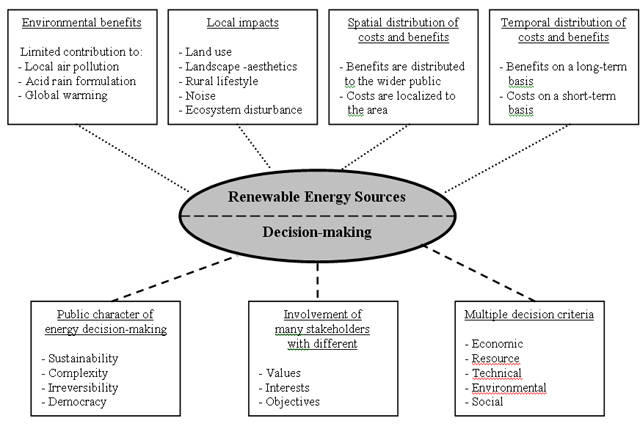
-------------------------------------------------------------------------
What is Multi-Criteria Decision Analysis?
Multi-Criteria
Decision Analysis (MCDA) deals with the process of making decisions in the
presence of multiple objectives. A Decision-Maker (DM) is to choose one
alternative among a set of alternatives, using two or more criteria. Usually
there is no alternative that performs better than all of the others according to
all criteria. Therefore, the solution is highly dependent on the preferences of
the decision-maker and must be a compromise.
For example, when someone
decides to buy a car, he usually considers simultaneously several criteria, like
price, speed, petrol consumption, prestige, safety, etc. In most of the cases
there is no car available that performs best in all the above criteria.
Therefore, the final choice depends on the DMs preference regarding these
criteria.
MCDA provides a formal way in order to ensure a structured
approach to such decisions. The problem if formulated to facilitate consistent
and rational thought. The expected out come is not however an acceptance of the
solution as providing by the decision modeling, but is a greater knowledge about
the intricacies of the problem and a clearer view of ones preferences.
Why MCDA and Renewable Energy
Sources?
The political, social,
economic and environmental importance of energy planning, to meet the
ever-increasing energy demand with adequate energy supply, renders the process
of decision-making between different energy projects a major challenge for
policy makers. This applies particularly for Renewable Energy Sources (RES),
since their particular features (decentralized production, localized and short
term cost, distributed and long term benefits, involvement of many stakeholders
and multiple-evaluation criteria) entails the use of specific instruments to
choose the best option for their evaluation.
A number of factors should therefore be taken into consideration. They emerge
from their decentralized character and the particularities imposed on the
corresponding decision-making process (Fig. 1). In most cases these parameters
can be operationalised through the inclusion of several technical, economic,
social, risk, and environmental criteria in the planning exercise. The
development procedure is even more complicated due to the involvement of the
stakeholders, influencing the decision-making process.

Fig. 1: Renewable energy sources and MCDA
On one hand RES alleviate the
global warming and other atmospheric problems resulting from fossil fuels
utilization, but on the other they impose severe local impacts associated with
extensive land use occupation (wind and solar projects), ecosystem disturbance
(hydro, geothermal, tidal plans), aesthetic degradation and loss of amenity
(wind parks distribution networks), noise production, etc. Thus RES while they
alleviate global burden, they create local environmental pressures of a varying
nature. At the global scale, there have been attempts to reduce CO2 emissions
(e.g. Kyoto Protocol) that bound the use of fossil power production and leaves
space to exploit the capacity of local environments to absorb adverse effects of
energy production.
Furthermore, the local-decentralized character of RES imposes an uneven spatial
distribution of their corresponding costs and benefits. In particular, RES
entail costs for the local communities while the resulting environmental and
other benefits are distributed over a wider scale through energy networks.
Moreover, on the time scale, RES involve long-term environmental and social
benefits (restriction of global warming, energy security and safety) and
short-term costs (loss of land, conflicts with other activities, reduction of
land value in the vicinity). These features of RES render the process of
choosing the best solution for their development a laborious task.
In addition, the public character of energy planning has increasingly received
much attention, particularly in the context of sustainable development in which
besides technical aspects, economic, environmental, land use and safety aspects
also play a combined role. This also implies that energy impact analysis and
evaluation is fraught with multiple problems, interests and stakeholders, and an
integrated RES investment appraisal is a multi-faceted activity, not easily
judged with a simple yardstick.
It goes without saying that these issues are in many cases not compatible
immediately. The multi-dimensional nature of renewable energy planning
objectives and projects renders the application of conventional financial
evaluation tools problematic and promotes the use of MCDA instruments
The MCDA process - Example of implementation of
different steps
Click on any cell of the following table to see additional information about each step and case study:
![]()
|
|
||||||||
|
1 Ikaria |
2 Troizina |
3 Andissa |
4 Polychnitos |
1 Ultrecth |
2 Flevoland |
1 Vallbona |
2 | |
| Types of RES | Wind & Hydro | Wind | Wind | Geothermal | Wind | Wind | Wind | PV |
|
|
|
|
|
|
|
|
|
|
|
|
|
|
|
|
|
|
|
|
|
|
|
|
|
|
|
|
|
|
|
|
|
|
|
|
|
|
|
|
|
|
|
|
|
|
|
|
|
|
|
|
|
|
|
|
|
|
|
|
|
|
|
|
|
|
|
|
|
|
|
|
|
|
|
|
|
|
|
|
The MCDA Tool Kit
The current Software
Decision Tool aims at providing guidelines that enable integrated Analysis of
RES investments. This process will aid in deciding about the appropriate project
to be implemented.
Right click here and select "Save target as" to download the MCDA tookit manual.
(click on the desired category or sub-category to see more information)
> Deliverable 7 Report: Data bases for manufactures, suppliers, consultants, authorities, experts, investors, NGOs
[zip file]
>
Deliverable 8 Report: Data base of costs, technologies, environmental pressures, regional planning issues(right click on the above desired link and select save target as to download the file to your copmuter)